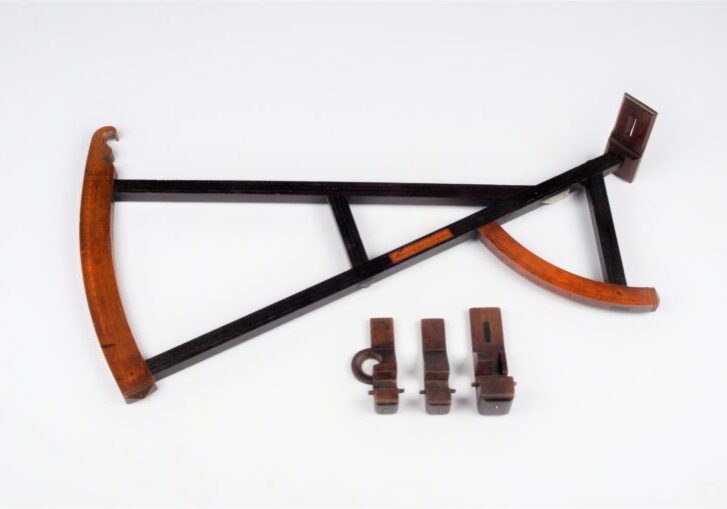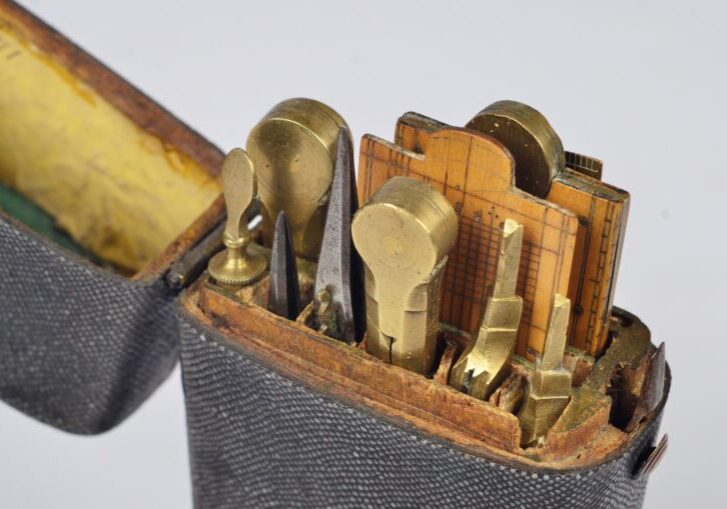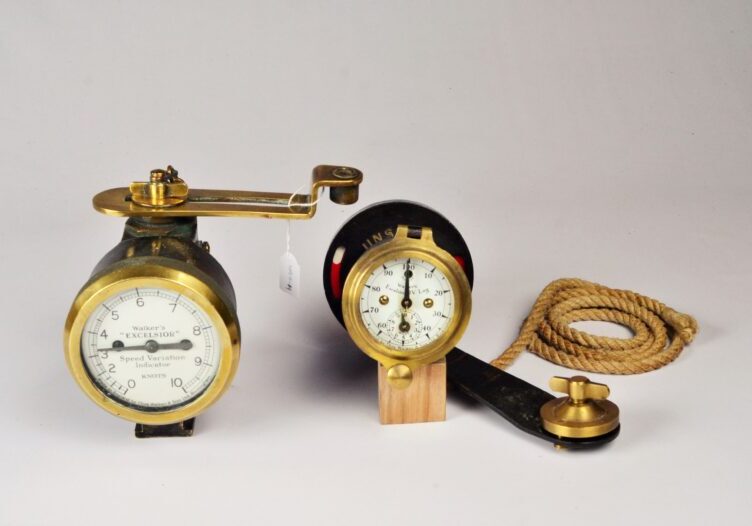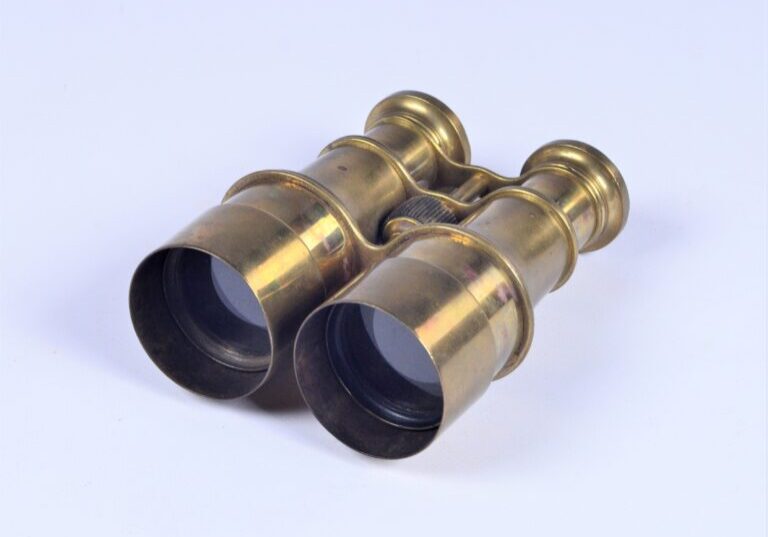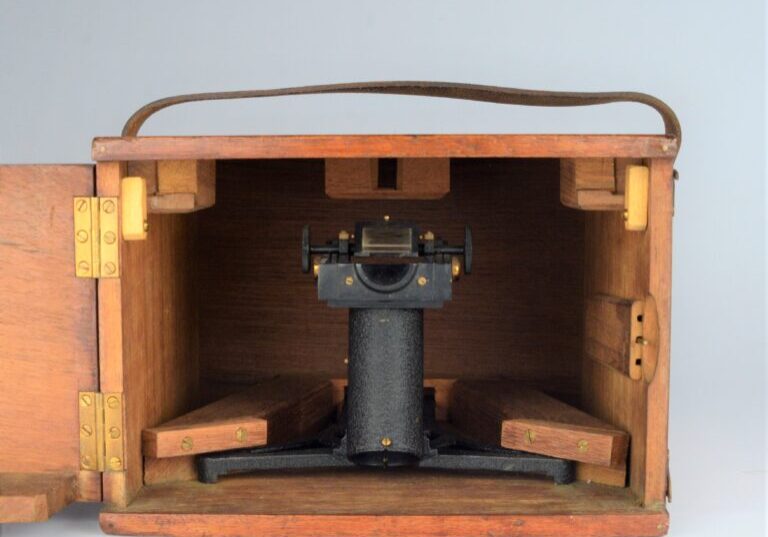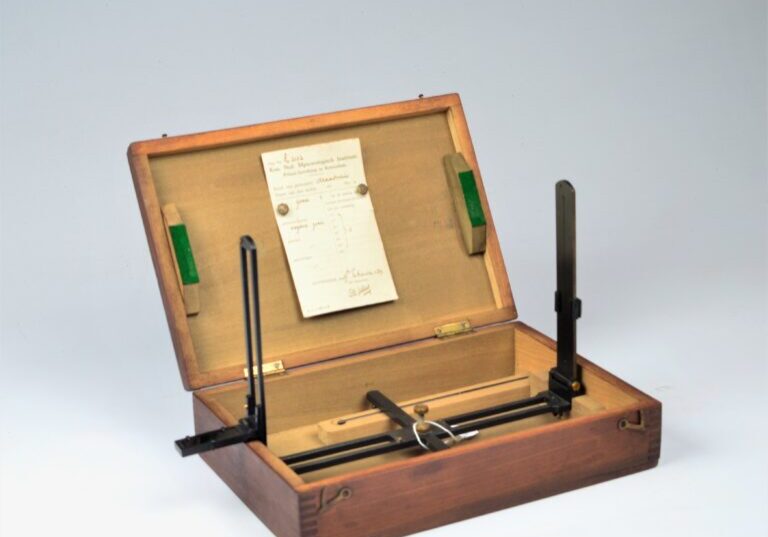Nautical instruments
This part of the collection includes mainly navigational instruments from the early sailing period, the time when ships were made of wood and men were made of steel.
After the astrhttps://archipel-img.com/wp-admin/edit.php?post_type=objectolabe and the Jacob’s staff, in 1595 John Davis invented the backstaff to determine the altitude of the sun at sea. His improved design became known as the Davis Quadrant. The observer stood with his back to the sun and didn’t have to look at the bright sunlight. The instruments has two concentric graduated arcs centered on the far end. The larger scale runs from 0 to 25 degress, the other one from 0 to 65. Together 90 degrees, a quadrant of a circle. On the edge of the small arc are placed secondary scribe marks, slightly offset to correct for the sun’s diameter of 16 arcminutes.
The backstaff remained in use until the late 1700s when the octant and sextant became the new preferred tools over the backstaff. The transversal nonius can be read accurate at two minutes.
This instrument is made of boxwood with an pearwood inlaid plate with the name of the maker in the main strut and with brass rivets. The scales are also made of pearwood. It has an original horizon vane. The other two vanes are exact copies of the Jonh Dupee backstaff, inhouse made of old pearwood. The lens in the shadow vane is specially made with the required power of 4 dioptres and a focal length of 20 centimetres. The lens concentrates a bright spot of sunlight on the horizon vane which allows the instrument to be used when clouds made the sun less bright. The vanes have brass pressure plates for holding them tightly in place on the degree arc. The sight vane has an inlaid brass pinhole sight. Decorative fleurs-de-lis and other decorative stamps are stamped in the frame. The transversal scale on the degree arc reads from 0° to 25° by 5 arcminutes, and reads to 1 arcminute along the fiducial edge of the sight vane. The graduation on the sixtyfive degree arc is from 0° to 65° by 1°.
Henry Gregory and his son, makers of nautical instruments, had their Navigation Warehouse from 1776-1783 at 148 Leadenhall, London. In 1783 they continued as Gregory and Wright and from 1789-1792 as Gregory, Gilbert and Wright (Webster database).
An identical instrument is in the collection of the Bristol Museum.
Catalogue: NM.5-34
Date: 1776-1783
HWL: 63.5×35.5×1.5 cm
Signed: H. Gregory near ye India House London
Origin: England
Condition: excellent, little wear consistent with age and use
Very nice brass azimut and bearing compass made by Elliott Brothers in London. Everything is present. The folding sight vane and prism, the unusual pale green paper dial, the protective cover. Given the engraving on the back, the instrument was the property of E.H.J. Calder.
Catalogue: NM.5-18
Date: around 1860
D: 72 mm
Signed: Elliott Brothers London
Rose: Elliott Brothers, Strand London
Origin: England
Condition: excellent
A fine and complete early 19th century shagreen cased set of chart work instruments.
All ten parts are original and present, including a boxwood sector and scale rule. Also made of brass, two dividers with complete and matching attachments for ink, pencil lines and dotting wheel, ink pen, brass protractor and brass mounted pencil. Brass bolts and lock.
Catalog: NM.6-02
Date: early 19th century
HWL: 17×7.5×3,5 cm
Signed: not signed
Origin: England
Condition: lock box worn, otherwise in good condition
Maritime artefacs
The pelorus is an instrument to make relative bearings against ship’s ahead or against compass heading. So it’s not a compass. The compass rose looks like a normal wind rose, but there is no compass needle.
The gimbaled brass instrument with brass rose is mounted in a mahogany case with tooth corner connection. On top of the rose is a bearing device with V and threat sight. The instrument stays in vertical position by a lead weight at the underside.
This nice instrument is complete and in a good condition. Maker’s name on the rose.
Catalog: NM.5-33
Date: c. 1920
HWL case: 22x29x29 cm
D rose: 19 cm
Signed: T.S. & T.D. Negus, New York
Origin: USA
Condition: in good and working condition, wear consistent with age and use
A ship-log records the distance travelled through the water. With the time in hours between the observations, it gives the ship’s speed in knots. With this log and the speed table also the speed can be determined with this log.
A very nice and complete set with clock, line, rotator, sinker weight, tin with oil, port and starboard shoe in a pine case with labels and instructions for use. There is also a time and knot table, the guarantee certificate, a speed table and an instruction in Swedish about placement and use of the log.
The log is fixed on a shoe at the port or starboard side of the stern. The recorder would have been connected with a line to the rotor at the end of the line. The govenor wheel is fitted in an open end housing. The enamel face with two dials.
The speed variation indicator with slotted outrigger arm is used in combination with a Excelsior IV yacht log as shown. The log has to be attatched to a spindle on top of the indicator. The pull of the line is used as a usefull aid to sail setting during sailing competitions. It hotes changes of speed down to 0,1 knot.
Catalog: NM.3-22
Date: ca. 1950
HWD case:L 14x39x19 cm (5.5×15.3×7.5 in)
Signed: Walker’s Excelsior IV Log and Walker’s “Excelsior” Speed Variation Indicator
Origin: England
Condition: perfect and complete, signs of use
Instruments intended for use at sea are usually made of brass to prevent corrosion from the action of salt. Similarly, this sea viewer. Solid and heavy copy, equipped with sun caps. The bag is missing a belt. The clasp shows wear. Very good optics.
Catalog: NM.1-15
Date: ca. 1900
LW: 12,5/14×11,5 cm
D: 5,5 cm
Signed: not signed
Origin: unknown
Condition: perfect
With the azimuth device on the compass the direction of a celestial body can be determined, expressed in degrees. Used, among other things, to determine the deviation of the compass.
The black lackered, brass instrument comes with a loose pen in a mahogany case with beautiful dovetail connections and leather carrying strap.
B. Cooke & Son Ltd. has a proud history since 1863 and reputation as British Admiralty Chart Distributor, Nautical Instrument Manufacturers and resellers and is still operating in Hull.
Catalog: NM.5-49
Date: ca. 1940
HWL: 15x19x23 cm
HWL case: 18.5×26.5×28 cm
Signed: B. Cooke & Son Ltd, instrument makers Hull, Est. 1863
Origin: England
Condition: in perfect condition, wear consistent with age and use
With the azimuth mirror on the compass the direction of a celestial body can be determined, expressed in degrees. Used, among other things, to determine the deviation of the compass.
The black lackered, brass instrument comes with a loose pen in a mahogany case with leather carrying strap.
Catalog: NM.5-47
Date: ca. 1940
HWL: 13x22x24 cm
HWL case: 16x26x25 cm
Signed: Kelvin, Bottomley & Baird Ltd. Glasgow
Origin: England
Condition: in perfect condition, wear consistent with age and use
Standard bearing sight with loose needle for use on the gauge compass. The box is assembled with tooth connections and is made of beautiful tulip wood. The device does not appear to have been used and is in excellent condition.
In 1939 the instrument has been checked by the Rotterdam department of the Koninklijk Meterorologisch Instituut.
Catalog: NM.5-46
Date: ca. 1930
HWL case: 7x29x19.5 cm
Signed: PP20
Origin: unknown
Condition: perfect


